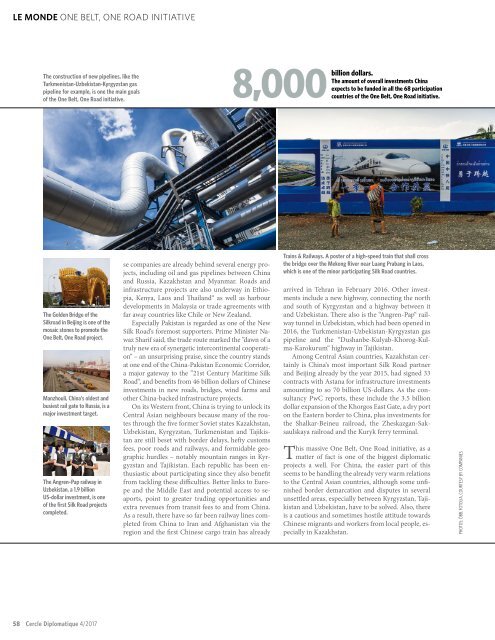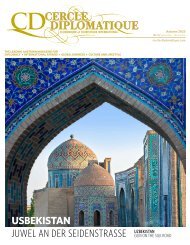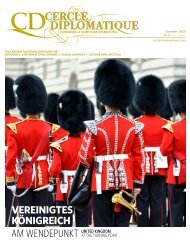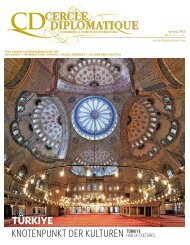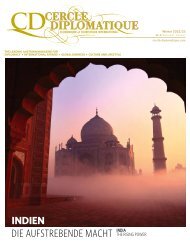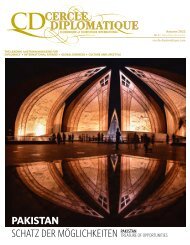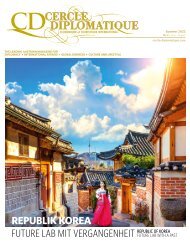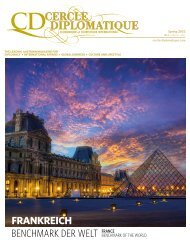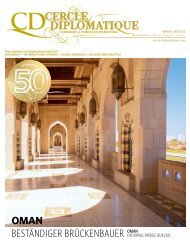CERCLE DIPLOMATIQUE - issue 4/2017
CD is an independent and impartial magazine and is the medium of communication between foreign representatives of international and UN-organisations based in Vienna and the Austrian political classes, business, culture and tourism. CD features up-to-date information about and for the diplomatic corps, international organisations, society, politics, business, tourism, fashion and culture. Furthermore CD introduces the new ambassadors in Austria and informs about designations, awards and top-events. Interviews with leading personalities, country reports from all over the world and the presentation of Austria as a host country complement the wide range oft he magazine.
CD is an independent and impartial magazine and is the medium of communication between foreign representatives of international and UN-organisations based in Vienna and the Austrian political classes, business, culture and tourism. CD features up-to-date information about and for the diplomatic corps, international organisations, society, politics, business, tourism, fashion and culture. Furthermore CD introduces the new ambassadors in Austria and informs about designations, awards and top-events. Interviews with leading personalities, country reports from all over the world and the presentation of Austria as a host country complement the wide range oft he magazine.
Create successful ePaper yourself
Turn your PDF publications into a flip-book with our unique Google optimized e-Paper software.
LE MONDE ONE BELT, ONE ROAD INITIATIVE<br />
The construction of new pipelines, like the<br />
Turkmenistan-Uzbekistan-Kyrgyzstan gas<br />
pipeline for example, is one the main goals<br />
of the One Belt, One Road initiative.<br />
8,000 countries<br />
billion dollars.<br />
The amount of overall investments China<br />
expects to be funded in all the 68 participation<br />
of the One Belt, One Road initiative.<br />
The construction of railway tunnels,<br />
especially in mountainous Central<br />
Asia, offers opportunities for<br />
Austrian technology suppliers.<br />
UNIQUE<br />
LUXURIOUS<br />
UNFORGETTABLE<br />
CELEBRATING NEW YEAR’S EVE<br />
The Golden Bridge of the<br />
Silkroad in Beijing is one of the<br />
mosaic stones to promote the<br />
One Belt, One Road project.<br />
Manzhouli, China‘s oldest and<br />
busiest rail gate to Russia, is a<br />
major investment target.<br />
The Angren–Pap railway in<br />
Uzbekistan, a 1.9 billion<br />
US-dollar investment, is one<br />
of the first Silk Road projects<br />
completed.<br />
se companies are already behind several energy projects,<br />
including oil and gas pipelines between China<br />
and Russia, Kazakhstan and Myanmar. Roads and<br />
infrastructure projects are also underway in Ethiopia,<br />
Kenya, Laos and Thailand“ as well as harbour<br />
developments in Malaysia or trade agreements with<br />
far away countries like Chile or New Zealand.<br />
Especially Pakistan is regarded as one of the New<br />
Silk Road‘s foremost supporters. Prime Minister Nawaz<br />
Sharif said, the trade route marked the ”dawn of a<br />
truly new era of synergetic intercontinental cooperation“<br />
– an unsurprising praise, since the country stands<br />
at one end of the China-Pakistan Economic Corridor,<br />
a major gateway to the ”21st Century Maritime Silk<br />
Road“, and benefits from 46 billion dollars of Chinese<br />
investments in new roads, bridges, wind farms and<br />
other China-backed infrastructure projects.<br />
On its Western front, China is trying to unlock its<br />
Central Asian neighbours because many of the routes<br />
through the five former Soviet states Kazakhstan,<br />
Uzbekistan, Kyrgyzstan, Turkmenistan and Tajikistan<br />
are still beset with border delays, hefty customs<br />
fees, poor roads and railways, and formidable geographic<br />
hurdles – notably mountain ranges in Kyrgyzstan<br />
and Tajikistan. Each republic has been enthusiastic<br />
about participating since they also benefit<br />
from tackling these difficulties. Better links to Europe<br />
and the Middle East and potential access to seaports,<br />
point to greater trading opportunities and<br />
extra revenues from transit fees to and from China.<br />
As a result, there have so far been railway lines completed<br />
from China to Iran and Afghanistan via the<br />
region and the first Chinese cargo train has already<br />
Trains & Railways. A poster of a high-speed train that shall cross<br />
the bridge over the Mekong River near Luang Prabang in Laos,<br />
which is one of the minor participating Silk Road countries.<br />
arrived in Tehran in February 2016. Other investments<br />
include a new highway, connecting the north<br />
and south of Kyrgyzstan and a highway between it<br />
and Uzbekistan. There also is the “Angren-Pap“ railway<br />
tunnel in Uzbekistan, which had been opened in<br />
2016, the Turkmenistan-Uzbekistan-Kyrgyzstan gas<br />
pipeline and the “Dushanbe-Kulyab-Khorog-Kulma-Karokurum“<br />
highway in Tajikistan.<br />
Among Central Asian countries, Kazakhstan certainly<br />
is China‘s most important Silk Road partner<br />
and Beijing already by the year 2015, had signed 33<br />
contracts with Astana for infrastructure investments<br />
amounting to so 70 billion US-dollars. As the consultancy<br />
PwC reports, these include the 3.5 billion<br />
dollar expansion of the Khorgos East Gate, a dry port<br />
on the Eastern border to China, plus investments for<br />
the Shalkar-Beineu railroad, the Zheskazgan-Saksaulskaya<br />
railroad and the Kuryk ferry terminal.<br />
This massive One Belt, One Road initiative, as a<br />
matter of fact is one of the biggest diplomatic<br />
projects a well. For China, the easier part of this<br />
seems to be handling the already very warm relations<br />
to the Central Asian countries, although some unfinished<br />
border demarcation and disputes in several<br />
unsettled areas, especially between Kyrgyzstan, Tajikistan<br />
and Uzbekistan, have to be solved. Also, there<br />
is a cautious and sometimes hostile attitude towards<br />
Chinese migrants and workers from local people, especially<br />
in Kazakhstan.<br />
PHOTOS: ÖBB, FOTOLIA, COURTESY BY COMPANIES<br />
One of the key diplomatic challenges in regard to<br />
the New Silk Road will naturally be managing the<br />
relations between China and Russia, which is at the<br />
time being, supposed to support OBOR since one of<br />
its own mega projects, the realisation of the so called<br />
West-East Corridor (an expansion of the Eastern Siberian<br />
railway) would be a perfect supplement of the<br />
One Belt, One Road network. On the other hand,<br />
Chinese investments in Central Asia are potential<br />
flashpoints, because Russia keeps Kazakhstan, Kyrgyzstan<br />
and possibly soon Tajikistan in its orbit<br />
through the Eurasian Economic Union (EEU). Russia<br />
can benefit from improved connectivity and<br />
therefore stability in the region, but it wants guarantees<br />
that One Belt, One Road won‘t undermine the<br />
economic relevance of the EEU.<br />
Finally, the European Union, as the British paper<br />
“The Conversation“ puts it, ”has been remarkably silent<br />
despite the projecs obvious geopolitical and economic<br />
importance“, given its trade volume with China<br />
of over 600 billion US-dollars in 2016. Apart from<br />
internal <strong>issue</strong>s like Brexit, experts attribute this somehow<br />
hesitant approach to the fear that One Belt,<br />
One Road might turn out as a double-edged sword.<br />
Connectivity should benefit everyone, but more<br />
competitive Chinese goods flooding Europe, could<br />
be a potential threat, unless EU members can coordinate<br />
their response. Being aware of possible counter<br />
reactions, Xinhua, the Chinese state-run media<br />
agency, already presented Beijing‘s point of view towards<br />
them: ”As some Western countries move backwards<br />
by erecting ‚walls‘, China is contriving to build<br />
bridges, both literal and metaphorical.“<br />
IN 220 METRES HEIGHT<br />
DINING buffet, live cooking, midnight snack<br />
DANCING live band<br />
PARTYING live DJanes<br />
ENJOYING breathtaking view of Vienna<br />
CREATING GOLDEN MEMORIES<br />
@ 57 RESTAURANT & LOUNGE<br />
events.melia.vienna@melia.com or +43 190 104<br />
Donau City Strasse 7 | 1220 Vienna (Austria)<br />
melia.com | 57melia.com | facebook.com/57melia<br />
instagram.com/57restaurant<br />
58 Cercle Diplomatique 4/<strong>2017</strong>


